 FOCUS, Bailey: MUSC approves a turkey of an idea
FOCUS, Bailey: MUSC approves a turkey of an idea
COMMENTARY, Brack: State should wisely target surplus funds
IN THE SPOTLIGHT: Charleston RiverDogs
GOOD NEWS: New map shows real power grip in South Carolina
FEEDBACK: Two great ways to send us your thoughts
MYSTERY PHOTO: Who painted this?
S.C. ENCYCLOPEDIA: Jasper Johns
CALENDAR: Homegrown Holiday Bazaar set for Dec. 1 on Johns Island
FOCUSFOCUS: MUSC approves a turkey of an idea
By Lynn Bailey, special to Charleston Currents | This week, I guess in honor of the turkey, the Medical University of South Carolina Board of Trustees approved a turkey of an idea: the acquisition of four poorly-performing hospitals from Community Health Systems (CHS), a for-profit health company that is rapidly selling off its underperforming assets.
The hospitals to be acquired are: Chester Hospital in Chester County, Springs Memorial Hospital in Lancaster County, Marion Hospital in Marion County and Carolinas Hospital in Florence. Except for Carolinas Hospital in Florence, all of the hospitals are located in rural counties and are in serious danger of bankruptcy and closing.
Additionally, CHS is unloading some more loser hospitals in the Upstate to Spartanburg Regional Health Center: Mary Black Health System in Spartanburg and Mary Black Health System in Gaffney. Spartanburg Regional Health Center is also a public health system controlled by Spartanburg County.
CHS must be thinking they’ve hit the “sucker” mother lode in South Carolina. What are these S.C. health care systems thinking? It looks like public-funded resources are bailing out for-profit private health systems, which was supposed to be the salvation of America’s health problems. A better deal would be to acquire these rural assets out of bankruptcy for pennies on the dollar. Sounds to me like public corporate welfare based on extortion in the name of rural care, dressed up as rural health rescue!
MUSC unloaded its hospital years ago with the creation of the MUSC Hospital Authority. Why does MUSC need more hospitals? Poorly-performing hospital requiring significant investment in locations out of the neighborhood need expensive upgrades and are difficult or costly to serve. [If they were making CHS margin, they wouldn’t be for sale.] How exactly, then, does this acquisition of “loser” facilities serve the MUSC education mission of training future health professionals like doctors, researchers, administrators and nurses?
It would be less expensive than to rescue rural health facilities for South Carolina to expand Medicaid. We’d at least receive federal matching funds and provide coverage to more working low-income South Carolinians. We could rescue more rural facilities like in Edgefield. Williamsburg, Abbeville and Allendale counties, as well as The Regional Medical Center of Calhoun and Orangeburg counties. It is too late for Fairfield Memorial, Marlboro Park, and hospitals in Bamberg and Barnwell counties.
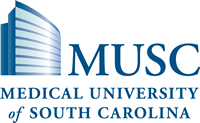 The MUSC-acquired hospitals are still tied to their local governments. CHS just leased the real estate. CHS then assumed the operating license. To transfer assets requires a two-year process and approval by county councils. The funds going from CHS for the original CHS acquisition have gone to community foundations to assist in providing care to low-income county residents. Cost of care is Chester, Lancaster, Marion and Florence counties has not gone down. If anything, it has increased. What happens to those resources? This is complicated.
The MUSC-acquired hospitals are still tied to their local governments. CHS just leased the real estate. CHS then assumed the operating license. To transfer assets requires a two-year process and approval by county councils. The funds going from CHS for the original CHS acquisition have gone to community foundations to assist in providing care to low-income county residents. Cost of care is Chester, Lancaster, Marion and Florence counties has not gone down. If anything, it has increased. What happens to those resources? This is complicated.
None of this requires public oversight. It doesn’t require a Certificate of Need from DHEC. It doesn’t require the oversight of the legislature or the executive branch. It may require tacit approval of the governor or review by the Attorney General but mostly the AG or the governor really don’t care what happens in South Carolina health care.
MUSC and its affiliated Hospital Authority are undertaking some out-of-the-box projects like redeveloping abandoned retail space for outpatient focused care, moving off the Charleston peninsula and directing care closer to where patients live and work. They want to construct a community hospital in Berkeley County to better serve patients from the Midlands and Upstate who need MUSC’s specialized care. They are advancing telemedicine by connecting specialized services across the state to communities where patients lack transportation to get to Charleston for care. Their students and residents do tours of duty delivering care in underserved communities. There are many was to serve the underserved in Chester, Lancaster, Marion and Florence counties without purchasing physical assets.
I don’t’ see the benefits. I see costs and headaches. My only explanation is MUSC needs to be seen as a “hospital system.” Regionally, there is PRISMA (Palmetto Health + Greenville Health System), Atrium (formerly known as Carolina Medical System which just merger with UNC Healthcare) in North Carolina, Novant also in N.C., MedStar in Atlanta or Mayo Clinic in Jacksonville, Fla. This doesn’t include the expanding for-profit systems such as HCA in Asheville or in North Charleston, or Tenet Healthcare in Mount Pleasant and Rock Hill. The access to capital for investor-owned companies are investors, but MUSC’s access to capital is often, directly or indirectly, taxpayers. Before MUSC heads down a rabbit hole, I want to know more about the details. The facilities to be acquired by MUSC are not a Black Friday bargain.
Health care economist Lynn Bailey lives in Columbia.
- Have a comment? Send to: editor@charlestoncurrents.com
BRACK: State should wisely target surplus funds
By Andy Brack, editor and publisher | The state of South Carolina has won the lottery. It has a billion dollars in surplus funds in the coming year that can be used  to address generational problems left lingering for far too long.
to address generational problems left lingering for far too long.
Let’s hope state lawmakers who let too many things get out of control because of too little money and vision don’t miss this gigantic opportunity to do a whole lot of good.
But in a state riddled with so many needs – we’re at the bottom in public education, college tuition is too high, more than half of state workers don’t earn a living wage and infrastructure is crumbling – how is it best to divide the money in ways that make strategic sense so the surplus isn’t just a political slush fund?
New, recurring funds
In the state’s 2019-20 budget, there will be about $458 million in new, recurring revenue stemming from the state’s growth and other sources. This is the pot of money that lawmakers usually argue over every year for new programs and additional costs that need to be funded on a recurring basis, such as health cost increases or extra pay for workers.
Perhaps the best investment for the state is to sink a large chunk of this money into the state’s teachers, who currently are paid at less than the Southeastern average. If we want more than average, we’re going to have to pay for it. Cost of a 5 percent raise for teachers: $155 million.
Being a state with some of the worst health outcomes, the state should invest $100 million on new programs to make citizens healthier and improve access to health care. Furthermore, another $100 million should be invested annually in further reduce the $21 billion unfunded liability of pension benefits for retirees and workers. We’re going to have to pay the piper at some point to deal with this liability; we might as well continue to reduce it with new money than have to raise taxes down the road to honor the state’s pension promises.
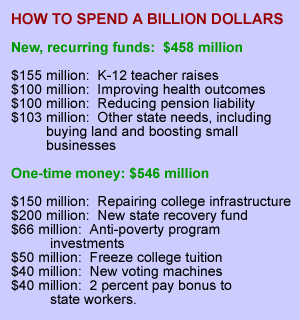 Of the remaining money – about $103 million – the state should prioritize remaining needs across all agencies, including spending money on bolstering small businesses and protecting special places by buying threatened land.
Of the remaining money – about $103 million – the state should prioritize remaining needs across all agencies, including spending money on bolstering small businesses and protecting special places by buying threatened land.
One-time money
Also available to use to shore up South Carolina’s needs is a $546 million pot of one-time money from past reserve funds and surpluses. Suggested priority areas for spending include colleges, infrastructure and employees:
College infrastructure. There’s been talk of borrowing $500 million to fix old college buildings and infrastructure. Instead of borrowing the amount, spend $150 million of surplus now to modernize.
Freeze tuition. The state also could spend $50 million to freeze tuition at state public colleges and universities, which have the highest tuition in the South. This would help make college more affordable to middle-class South Carolinians.
Recovery fund. Since we now seem to have a big natural disaster every year or two, let’s start a new disaster recovery fund of $200 million to be ready in the future for the next weather-related hit.
Voting machines. South Carolina has outdated voting machines that do not inspire confidence. While $10 million has been set aside for new machines, another $40 million needs to be spent to buy 13,000 new machines that have paper trails.
Bonuses. State workers get the short end of the pay stick, year after year. Let’s spend $40 million on a one-time, 2 percent bonus.
Anti-poverty programs. The remaining one-time money – about $66 million – should be used to seed a multitude of anti-poverty efforts by nonprofits and churches dedicated to improving lives of South Carolinians at the bottom of the socio-economic scale.
Let’s not fall for the old bait-and-switch that surpluses need to be returned to taxpayers in a state that has underfunded priorities for years. If lawmakers fall prey to this ruse again, you know who will get most of the extra money – rich folks.
Let’s do the right thing and make sure lapsed needs are met. Let’s not waste this opportunity to invest the surpluses in South Carolina’s future.
- Have a comment? Send to: editor@charlestoncurrents.com
SPOTLIGHT: Charleston RiverDogs
 The public spiritedness of our underwriters allows us to bring Charleston Currents to you at no cost. This issue’s featured underwriter is the Charleston RiverDogs, whose ballplayers just finished another great regular season.
The public spiritedness of our underwriters allows us to bring Charleston Currents to you at no cost. This issue’s featured underwriter is the Charleston RiverDogs, whose ballplayers just finished another great regular season.
In 2018, the club celebrated its 25th season (that’s 175 years in “Dog” years!!) and, for the second season in a row, hosted more than 300,000 fans. The team had a 64-72 record, but saw 15 players promoted to higher levels in the club’s structure during the season. Click here to review the season.
The Lowcountry’s leader in sports entertainment, Charleston RiverDogs baseball is an attractive, affordable medium for your group or business. The RiverDogs develop the next major league stars for the 27-time World Champion New York Yankees at one of the finest ballparks in Minor League Baseball — Joseph P. Riley, Jr. Park.
Three short words sum up the everyday approach taken by the Charleston RiverDogs front office. The brainchild of club President Emeritus Mike Veeck, the nine-letter phrase “Fun Is Good” is meant to be a guideline and daily reminder of how employees should approach their jobs and in turn capture the imagination of the fans to turn them into repeat customers.
- Visit the ‘Dogs online at: RiverDogs.com
- To meet all of our underwriters, click here.
GOOD NEWS: New map shows real power grip in South Carolina
Staff reports | Our sister publication, Statehouse Report, provided an interesting map of where real power in the S.C. House lives in its recent issue. The map, inspired by a report in The New York Times, is proportional making geographically-large districts the same size as compact ones. The result? As highlighted above, the Republican Party totally dominates the S.C. House of Representatives (we knew it has an 80-44 grip on power, but the map shows the Upstate’s grip on politics.).
- Read the full story here and compare it to a geographically-based map.
Also in Good News:
![]() Giving Tuesday. Tomorrow is Giving Tuesday. Don’t forget to remember your favorite LOCAL nonprofit.
Giving Tuesday. Tomorrow is Giving Tuesday. Don’t forget to remember your favorite LOCAL nonprofit.
Clemson wins again. Clemson University fans beat South Carolina fans in the 34th annual American Red Cross Carolina-Clemson Blood Drive. This year’s event resulted in 4,684 donors presenting to give blood. Carolina supporters totaled 1,956, or 7 percent of the undergraduate population, while Clemson supporters totaled 2,728, or 14 percent of the undergraduate population.
350th anniversary events start. The city of Charleston will launch its 350th anniversary commemoration Nov. 26 with a book release event for In Darkest South Carolina, a biography of Charleston Judge Julius Waties Waring by Brian Hicks. Time and location: 6 p.m., Charleston Museum, 360 Meeting St. The free event will be the first in a series of educational and cultural celebrations to commemorate the city of Charleston’s rich history and 350th anniversary in 2020. City Council established the City of Charleston 350th Celebration Steering Committee earlier this year to guide the process.
Frazier promoted. Longtime Currents’ friend Herb Frazier has been promoted to public relations director as part of an effort by Magnolia Plantation and Gardens to spread its message nationwide. Kirk Brown has been named to the newly-created position of outreach coordinator. Congrats, guys!
Melville appointed. Retired U.S. Ambassador James D. Melville Jr. has been appointed as associate dean for international and community outreach at the College of Charleston’s School of Languages, Cultures and World Affairs and as a faculty member in the school’s International Studies program. Most recently, Melville served as U.S. Ambassador to Estonia (2015-18).
FEEDBACKTwo great ways to send us your thoughts
We’d love to get your impact in one or more ways:
Send us a letter: We love hearing from readers. Comments are limited to 250 words or less. Please include your name and contact information. Send your letters to: editor@charlestoncurrents.com. | Read our feedback policy.
Tell us what you love about the Lowcountry. Send a short comment – 100 words to 150 words – that describes something you really enjoy about the Lowcountry. It can be big or small. It can be a place, a thing or something you see. It might the bakery where you get a morning croissant or a business or government entity doing a good job. We’ll highlight your entry in a coming issue of Charleston Currents. We look forward to hearing from you.
MYSTERYMYSTERY PHOTO: Who painted this?
This excerpt of a painting of a South Carolina scene may look like a watercolor, but it isn’t. But it should look familiar. Who painted it and what is it? Send your guess to: editor@charlestoncurrents.com. And don’t forget to include your name and the town in which you live.
Our previous Mystery Photo
 Our Nov. 19 mystery, “Who is this guy?” is a photo of Jasper Johns, a world-famous artist recognized as South Carolina’s own (despite the fact that he was actually born in Augusta.) See this week’s Encyclopedia to learn more.
Our Nov. 19 mystery, “Who is this guy?” is a photo of Jasper Johns, a world-famous artist recognized as South Carolina’s own (despite the fact that he was actually born in Augusta.) See this week’s Encyclopedia to learn more.
A holiday thanks to the photo sleuths who correctly identified Johns: Cheryl Smithem of Summerville; James McMahan and Susu Ravenel, both of Charleston; and George Graf of Palmyra, Va.
Smithem told us: “I worked with his sister Owen Riley Lee at the Spoleto festival USA in 1980 and she always called him JAP. He’s a South Carolina icon.”
Graf provided more context: “Johns is one of the greatest American artists and among the most prominent artists of the 20th century. In 1990, he was awarded the National Medal of Arts. On Feb. 15, 2011 Johns received the highest civilian honor in the United States, the Presidential Medal of Freedom, from President Barack Obama. Today, he remains at the forefront of American art and his work is represented in nearly every major museum collection. South Carolinians look with pride on the achievements of Jasper Johns, an internationally known artist who has astonished critics and collectors alike with the beauty, invention, and intelligence of his work.”
- Send us a mystery: If you have a photo that you believe will stump readers, send it along (but make sure to tell us what it is because it may stump us too!) Send it along to editor@charlestoncurrents.com.
HISTORY: Jasper Johns
S.C. Encyclopedia | Artist Jasper Johns was born in Augusta, Georgia, on May 15, 1930, probably because its hospital was the closest one to Allendale, South Carolina, where his parents were living. His father, William Jasper Johns, was a farmer and former lawyer who divorced his mother, Jean Riley, by the time the artist was three years old. Johns spent his childhood with various family members in Allendale, Columbia, Batesburg, and Sumter, where he graduated from high school in 1947. He attended the University of South Carolina from September 1947 until December 1948, when he moved to New York. In May 1951 he was inducted into the United States Army and was stationed at Fort Jackson until he was sent to Japan during the Korean War. Upon his discharge he moved to Manhattan and resided there until the mid-1990s, with regular sojourns spent at Edisto Beach, South Carolina (1961–1966), Saint Martin, French West Indies (1969–), and Stony Point, Long Island (1974–1991).
In 1954 Johns destroyed all of his previous work and began two of his signature series: the flag and the target. Four years later his career had clearly been launched: the prestigious Leo Castelli Gallery began to handle his art, the Museum of Modern Art acquired several of his works, and he represented the United States at the Venice Biennale. Johns is a pivotal figure of twentieth-century American art, occupying a critical position that mediates Abstract Expressionism, Pop Art, and Minimalism. Like the latter, he is interested in art materials; he is proficient in a variety of media, including drawing and lithography, oil and encaustic painting, and collage and assemblage. Using commonplace subjects—such as the American flag, numbers, or a beer can—he discharges a fundamental tenet of his art: “Take an object. / Do something to it. / Do something else to it.”
Johns’s career falls into three broad periods: early work characterized by great detachment, abstract work from the early 1960s and 1970s that often emphasizes patterns, and imagery from the 1980s that is more personal and based on early recollections. For example, he incorporated symbols relating to his step-grandmother in several paintings emblematic of his childhood, and in 1992 he employed a floor plan of his grandfather’s house in Allendale. Four years later the Museum of Modern Art organized Jasper Johns: A Retrospective, which attempted to identify his sources, present his biography and achievements, and assess his place in modern art. In the accompanying catalogue, curator Kirk Varnedoe acknowledged Johns’s influential role: “Johns’s presence can be felt at or near the origin point of virtually every generative idea of importance in avant-garde painting and sculpture in America for four decades.”
[Added:] Johns, whose body of work is one of the most valuable in the art world, currently lives in Connecticut. More.
— Excerpted from an entry by Martha R. Severens. This entry hasn’t been updated since 2006. To read more about this or 2,000 other entries about South Carolina, check out The South Carolina Encyclopedia, published in 2006 by USC Press. (Information used by permission.)
ON THE CALENDARCALENDAR: Homegrown Holiday Bazaar set for Dec. 1 on Johns Island
Staff reports | The fifth annual Homegrown Holiday Bazaar will be held 10 a.m. to 4 p.m. Dec. 1 at islanders Farmers Market, 3546 Maybank Highway, on Johns Island. The event will serve as the farmers market for that day and is brought to you by the Islanders Farmers Market and Sea Islands Chamber of Commerce.
The bazaar will feature more than 100 vendors and farmers, just in time to get holiday shopping done from local businesses in support of your local economy. The Holiday Carriage and Hay Rides, Antique Tractor Show, Kiddie train ride, Pony Rides, and Santa & Mrs. Claus visits in Santa Land are sure to bring holiday cheer to all who visit!
Local food trucks will be on site along with warm drinks, local craft beer and wine. Ocean Drive Party Band of Charleston will be starting the day off with some great energy through 1 p.m. followed by Charleston’s own local musician White Jeep.
Activities for all ages include several seasonal-themed games, crafts, cookie decorating, ornament making, hula-hooping and bounce houses. There’s also a silent auction to support the operations of both hosting organizations.
Admission is free and there is plenty of free parking on site. Some vendor spaces still are open. To find out more about the Homegrown Holiday Bazaar, call Karen Thompson at 843-793-1234 or visit
Also on the calendar:
![]() Holiday Festival of Lights. The Holiday Festival of Lights is in full swing at James Island County Park every evening through Jan. 1, 2019. This spectacular light show, now in its 29th year, is one of Charleston’s most beloved holiday events, featuring an estimated two million shimmering lights. The Holiday Festival of Lights is every evening at 5:30 p.m. nightly and closes at 10 p.m. Sunday through Thursday and 11 p.m. Friday and Saturday. More info: http://www.HolidayFestivalofLights.com
Holiday Festival of Lights. The Holiday Festival of Lights is in full swing at James Island County Park every evening through Jan. 1, 2019. This spectacular light show, now in its 29th year, is one of Charleston’s most beloved holiday events, featuring an estimated two million shimmering lights. The Holiday Festival of Lights is every evening at 5:30 p.m. nightly and closes at 10 p.m. Sunday through Thursday and 11 p.m. Friday and Saturday. More info: http://www.HolidayFestivalofLights.com
Yuletide Madrigal Feast: 7 p.m. on Nov. 29, 30 and Dec. 1, Circular Congregational Church, 150 Meeting St., Charleston. The Department of Music in the College of Charleston School of the Arts will host a feast and performance of the college’s award-winning Madrigal Singers conducted by Dr. Robert Taylor. They will perform sacred and secular traditional holiday carols in a dinner theatre format. Tickets range from $45 to $65. More: music.cofc.edu.
THAT Holiday Book Sale: Nov. 30 to Dec. 1, Mount Pleasant Regional Library, 1133 Mathis Ferry Road in Mount Pleasant. Looking for some extra stocking stuffers this Christmas? Shopping for Kwanzaa or a New Year’s Party? Come shop the Charleston Friends of the Library Holiday Book Sale, and support your local library system for the holidays. Learn more: CharlestonLibraryFriends.org
Guevara art show: Nov. 30 to Jan. 11, 2019 (Tuesdays through Saturdays), Redux Contemporary Art Center, 1056 King St., Charleston. Redux will present new work by fiber artist Camela Guevara in a show titled “Care Work.” Click to learn more.
Light the Lake: 5:30 p.m. to 7:30 p.m., Nov. 30, Colonial Lake, Charleston. The Charleston Parks Conservancy will celebrate a tree lighting at the lake and will have good trucks on site and a DJ playing holiday music. More.
Gospel Christmas: 7:30 p.m., Dec. 1, Burke High School Auditorium, 244 President Street, Charleston. The Charleston Gospel Choir presents the 19th annual Gospel Christmas to bring the real meaning to Charleston’s musical landscape by performing down-home traditional spirituals and gospel renditions including s including gospel arrangements of Carol of the Bells, Do You Hear What I Hear, and Little Drummer Boy. The performance will be conducted by Dr. Antoine T. Clark and will feature the Gospel Christmas Orchestra comprised of regional musicians for a rousing celebration of gospel favorites, moving spirituals, and festive holiday arrangements. This year, the Queen City Singers of Charlotte, directed by D.J. Boyd, will join the Charleston Gospel Choir. Boyd guest conducted the choir in Spring 2015. Tickets are $35 for adults, $30 for seniors and $15 for students. Learn more online.
Sweets with Santa: 11:30 a.m. to 2 p.m., Dec. 2, Charleston Gaillard Center, Charleston. Before Charleston’s annual holiday parade, take your kids to the Gaillard to enjoy free photos with Santa and Mrs. Claus, free cocoa, fun crafts and a concert with Charleston Singleton and Friends. RSVP.
Early morning bird walks at Caw Caw: 8:30 a.m. every Wednesday and Saturday, Caw Caw Interpretive Center, Ravenel. You can learn about habitats and birds, butterflies and other organisms in this two-hour session. Registration not required, but participants are to be 15 and up. $10 per person or free to Gold Pass holders. More: http://www.CharlestonCountyParks.com.
AREA FARMERS MARKETS
SATURDAYS: The holiday Charleston Farmers Market, will be open Dec. 1, 2, 8. 9, 15 and 16.
SATURDAYS: Johns Island Farmers Market operates each Saturday from 9:30 a.m. to 1:30 p.m. year-round with more than 50 local farmers and vendors, food trucks, music and more. The market is located on the campus of Charleston Collegiate School, 2024 Academy Road, Johns Island.
SATURDAYS: The Town Market on James Island is closed for the season, but a holiday market is set for Dec. 7. Click the link for details. Location: James Island Youth Soccer Club, 871 Fort Johnson Road, James Island.
- If you have an event to list on our calendar, please send it to feedback@charlestoncurrents.com for consideration. The calendar is updated weekly on Mondays.
If you like what you’ve been reading, how about considering a contribution so that we can continue to providing you with good news about Charleston and the Lowcountry. Interested? Just click the image below.
https://charlestoncurrents.com/donate/
ABOUT CHARLESTON CURRENTSOUR UNDERWRITERS
Charleston Currents is an underwriter-supported weekly online journal of good news about the Charleston area and Lowcountry of South Carolina.
- Meet our underwriters
- To learn more about how your organization or business can benefit, click here to contact us. Or give us a holler on the phone at: 843.670.3996.
OUR TEAM
Charleston Currents offers insightful community comment and good news on events each week. It cuts through the information clutter to offer the best of what’s happening locally.
- Mailing address: O. Box. 22261 | Charleston, SC 29413
- Phone: 670.3996
Charleston Currents is provided to you weekly by:
- Editor and publisher: Andy Brack, 843.670.3996
- Contributing editor, common good, Fred Palm
- Contributing editor, money: Kyra Morris
- Contributing editor, Palmetto Poem: Marjory Wentworth
SUBSCRIBE FOR FREE
Subscriptions to Charleston Currents are free.
- Click here to subscribe.
- We don’t want to lose you as a reader of Charleston Currents, but if you must unsubscribe, you will have to do it through the email edition you receive. Just go to the bottom of any of your weekly newsletters and click the “unsubscribe” function. If that doesn’t work, please send us an email with the word “unsubscribe” in the subject line.
© 2008-2018, Statehouse Report, LLC. All rights reserved. Charleston Currents is published every Monday by Statehouse Report LLC, PO Box 22261, Charleston, SC 29413.


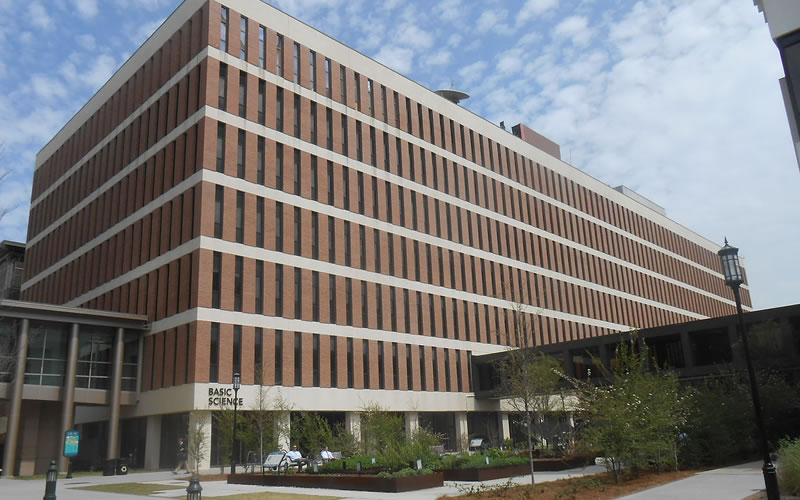


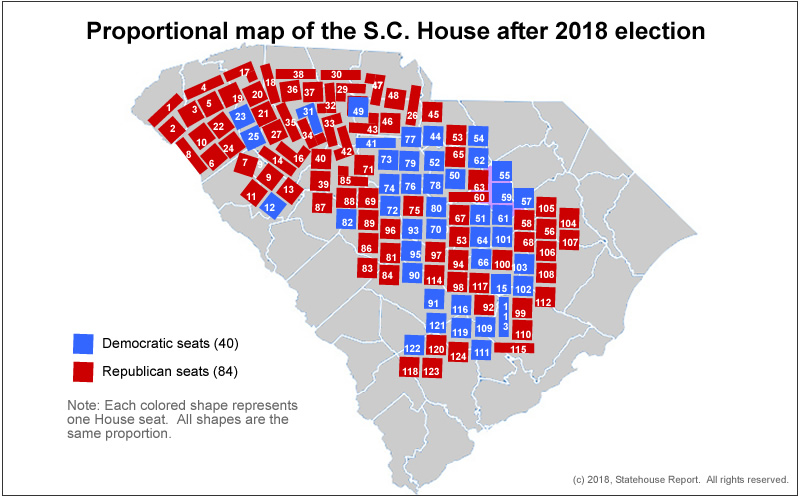


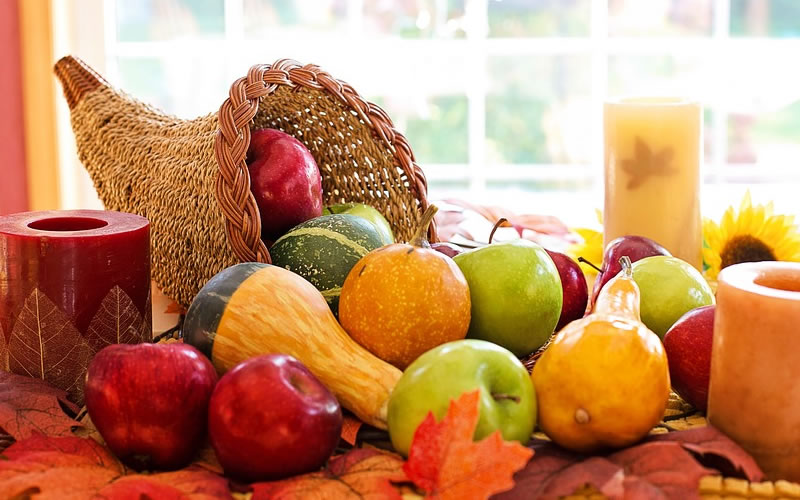

 We Can Do Better, South Carolina!
We Can Do Better, South Carolina!
























